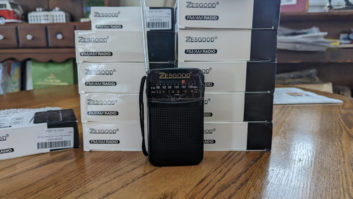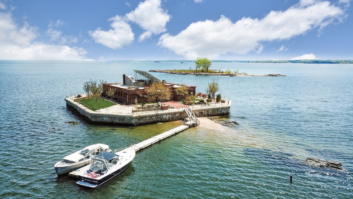This article includes research presented at the 2016 Saving America’s Radio Heritage Conference held by the Radio Preservation Task Force in Washington.
FROM THE EDITOR
Radio World supports efforts to save our radio heritage including the work now being done by the Radio Preservation Task Force (http://radiopreservation.org). Here is the fourth in a series of guest commentaries by or about those involved in that effort. Author Anne F. MacLennan is an associate professor in the Department of Communication Studies and former graduate program director of the Joint Graduate Program in Communication & Culture at York University, Toronto, Ontario.
— Paul McLane
The Radio Preservation Task Force faces a mammoth undertaking: It is tasked with preserving and archiving American broadcasting.
The reach of that broadcasting, however, is not confined to the boundaries of the United States of America. In fact, in the 1920s and 1930s, NBC, CBS and MBS all established affiliates within the boundaries of Canada.
Material evidence of American radio persists in Canadian archives and forms part of the early history of the country’s broadcasting, not only as stations that could be heard over a signal-porous border but from within Canada itself.

An image of the CKGW transmitter site in Bowmanville in 1928, before the station moved to Toronto and affiliated with NBC.
Image courtesy City of Toronto Archives.
SCRUTINY
As regulations tightened in the United States and Canada in the 1920s and 1930s, American radio signals broadcasting across the border and American affiliate stations established in Canadian cities both came under scrutiny.
Most Canadians lived close enough to pick up powerful American stations on clear channels in the evenings. Technical changes were put in place so that powerful U.S. stations did not dominate, including the use of directional antennas and regulation of frequency utilization.
Immediately after World War I, amateur broadcasters prevailed under light regulation. But as more stations filled the airwaves, interference from distant stations, weather conditions and finally the reallocation of radio frequencies disrupted the audience’s enjoyment of radio programs. Radio became dominated less by hobbyists and increasingly was influenced by listeners who wanted to hear their favorite programs. Regulation became more important.
NBC and CBS stations that crossed the northern border were broadcasting to Canadians and were part of the American networks.
The popular misconception that Canadians listened almost exclusively to U.S.-based stations was disproved by the establishment of American-affiliated stations in Toronto, Montreal and later Windsor.
CKGW in Toronto and CFCF Montreal were NBC-affiliated stations that enabled the network’s programs to broadcast over Canadian airwaves. CBS provided a more select variety of programs on CFRB in Toronto and on CKAC (now the largest French-language station in Montreal), which existed as a bilingual station with local English and French content and also included CBS content in the mix during the ’20s and early ’30s.
The American Radio Act of 1927 and creation of the Federal Radio Commission were followed by reallocation of radio wavelengths across North America. Strict technical requirements forced many small American stations off the air; but small, private, local stations, not part of any chain, persisted in Canada.
In Canada, the Radio Broadcasting Act was not enacted until 1932, but in the intervening five to six years, stations in Canada joined NBC and CBS.
Following the reallocation, Canadians and Americans were dismayed by the loss of favorite stations and programs. A convergence of factors following this disruption permitted drastic changes in Canada.
ONE PER CITY
With the exception of Montreal and Toronto, Canadian cities were limited to one frequency per city, in order to serve listeners who were tuning in with crystal sets rather than expensive radios with tuning knobs. Crystal sets were more likely to be found in American and Canadian cities until the introduction of tabletop radios in 1931.
The shortage of radio frequencies assigned to Canada in the North American Gentleman’s Agreement of 1924 — allowing only six exclusive wavelengths and 11 shared wavelengths — forced a variety of Canadian cities to share wavelengths. Larger companies that hoped to acquire a city radio station often had to settle for a signal outside the city, sometimes outside of the province, hoping it could still reach listeners in the desired location. Therefore, it was challenging for American affiliates to acquire their own stations without a shared wavelength.
Letters began arriving at the offices of the Radio Branch of the Ministry of Marine and Fisheries, complaining not only about interference from the reallocated Canadian and American stations but also the religious criticism of Judge Rutherford, president of the Watch Tower Society, which was broadcast over International Bible Students Association radio stations.
The minister of Marine and Fisheries exercised his only power by cancelling the IBSA licenses. This action provoked debate in the House of Commons over the power exerted by the ministry. That same year, the regulation of radio broadcasting was questioned and a few slots for new radio stations were created. In December 1928, a formal inquiry into the future of Canadian radio commenced with the appointment of the Royal Commission on Radio Broadcasting, commonly known as the Aird Commission.
Soon NBC became the first of the American networks to enter Canada with the physical presence of an affiliate station. On Nov. 16, 1929, R.W. Ashcroft, manager of the Trans-Canada Broadcasting Company, announced that CKGW would begin to broadcast programs from NBC’s Red and Blue networks, making it the first American affiliate to offer American programming in Canada.
Shortly thereafter, Montreal’s CFCF became an NBC affiliate. CFRB affiliated with CBS. And CKAC added CBS programs when it became an affiliate.
While Canada moved tentatively toward regulation and the creation of a national public radio broadcasting network, Canadian stations continued to join American networks and carry American programming. After the Radio Broadcasting Act, the Canadian Radio Broadcasting Commission broadcast select programs on the national network as well. The Canadian Broadcasting Act of 1936 established the Canadian Broadcasting Corp., which introduced more American programming on its own stations and permitted its continued inclusion in the schedules of private Canadian broadcasters throughout the interwar years.
Anne F. MacLennan’s research on radio has been published in “Journal of Radio & Audio Media,” “Women’s Studies: An Interdisciplinary Journal” and “The Radio Journal.” Her ongoing research focuses on radio programming in the 1930s, the radio audience in the 1930s, broadcasters, and the design and promotion of early radio.
Radio World welcomes your own stores about the preservation of radio content as part of our ongoing coverage of the RPTF effort. Email ideas to [email protected].












